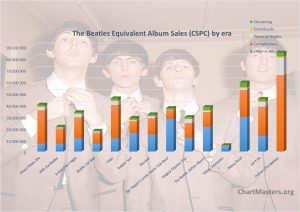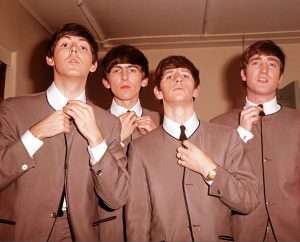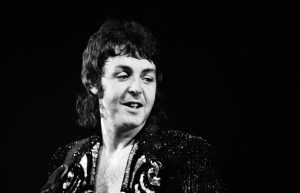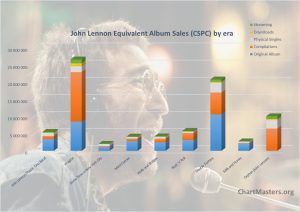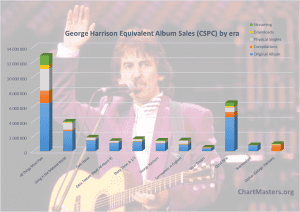John Lennon albums and songs sales
The Beatles‘ achievements are widely covered by the press and Imagine was elected the greatest song in the past 100 years by polls from multiple countries at the turn of the millennium.
Record sales of John Lennon are unknown by the general public yet. It’s time to put them under the microscope, untapping over 82 million equivalent album sales!
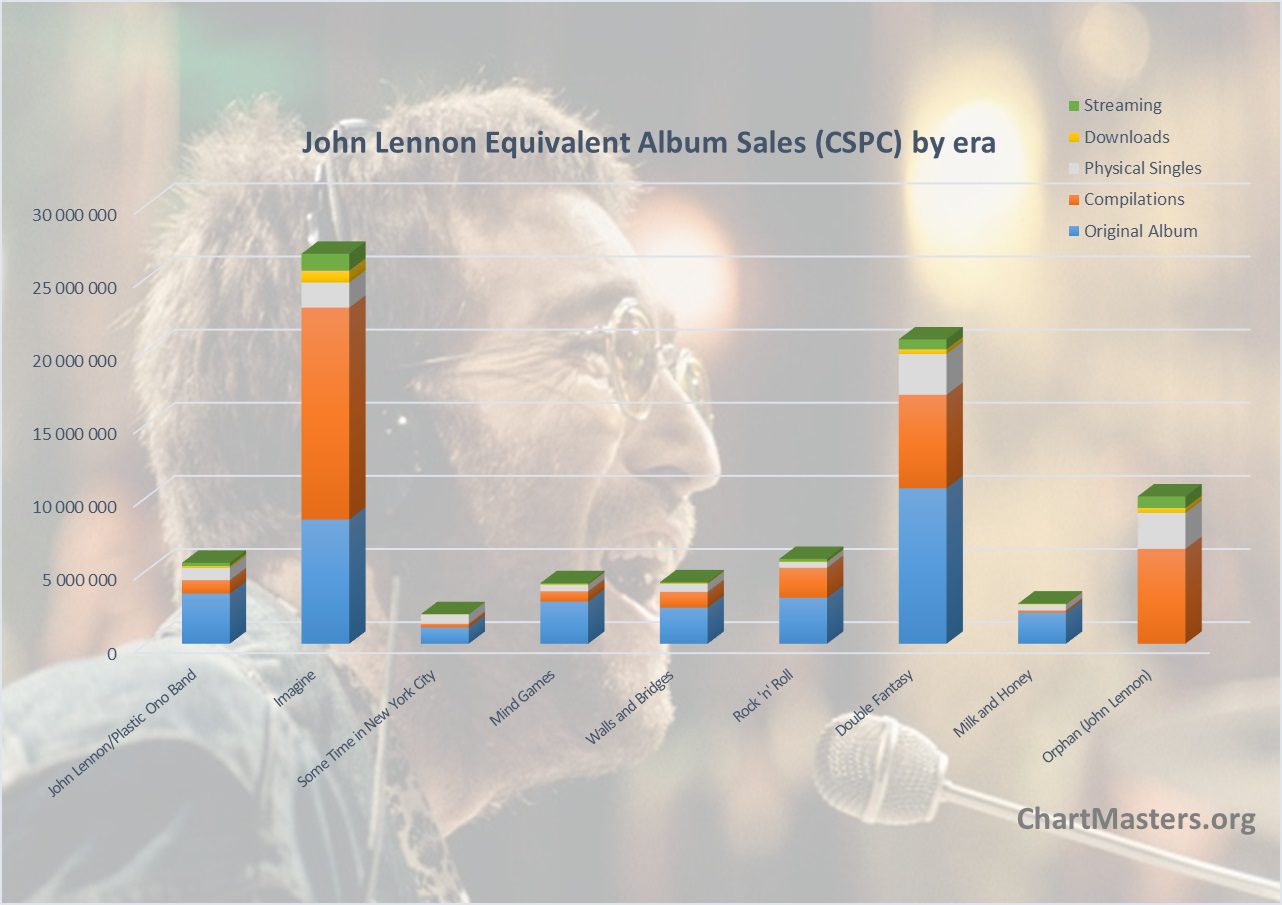
Looking at the big picture: John Lennon
A rebellious child (1940-1955)
John Winston Lennon was born on October 9, 1940, in Liverpool, England, amid the chaos of WWII. His childhood was marked by instability and early emotional struggles. His father, Alfred Lennon, was often absent, working as a merchant seaman and eventually abandoning the family when John was young.
His mother, Julia, who was warm, free-spirited and erratic, found it difficult to provide a stable home. Consequently, John was sent to live with his Aunt Mimi (real firstname Mary, elder sister of Julia) and her husband Uncle George, who raised him with stricter boundaries.
He spent his childhood between his aunt, her husband, his mother, her new man, and his two half sisters from Julia‘s new couple. He never knew he had a third one born just after him. Born from a short-lived affair by his mother while his father was at see, she was given for adoption. Later on, when he discovered the story, he tried to find her, but she remained silent until the late 90s and the passing of her adoptive mother to respect her promise.
His only stable influence was Aunt Mimi, but she disapproved his growing interest in music, while Julia continued to nurture his passion by teaching him to play the banjo and introducing him to early rock and roll.
John’s complex family dynamics and shifting caregivers shaped his personality. He grew up sharp-witted, rebellious, and defensive, often using humor as a shield to cope with emotional pain. In school, he was known as a troublemaker, resisting authority and clashing with teachers. All he needed was a catalyzer to invest all this energy and will in an effective way.
The making of the Beatles (1956-1962)
By the time he was 15, John Lennon’s passion for music had fully blossomed after his mother gifted him his first guitar. His academics were not his priority. He failed his O-level examinations, and was unable to complete his first year in the College of Art. Ironically, he named his first band, after his Quarry Bank High School. The Quarrymen were founded in 1966, , he fully channeled his emotions into this new project.
He quickly recruited several friends from his school, and they started playing skiffle on parties and cinemas. As Lennon moved more into rock and roll, some members left. One that arrived in mid-1957 after meeting him in a show was Paul McCartney. In early 1958, the latter convinced John to welcome his young but talented friend, George Harrison.
This year would happen to be devastating for 17-years old Lennon. On July 15, 1958, his mother Julia, after visiting her sister Mary, was struck and killed by a car in the street in front of the house. For the next years, Lennon drowned his sorrow in alcohol, ruined for good his studies, and was always willing to get into a fight.
The only place where he was able to bring something positive from his rage was once again music. His friendship with McCartney also got stronger ties, as he also lost his mother a bit earlier. Despite the fact he had lost his prime supporter in his mother, he continued to push his band to higher grounds. Renamed The Beatles in 1960, the elevator was named Brian Epstein.
A local entrepreneur, he saw something in the Beatles earlier than anyone else in the industry. They had their share of fame when the meeting happened in 1961, as they did a long residency in Hamburg a year earlier. They were still too wild, and appeared too unprofessional for record labels and radio stations.
In only a year, Epstein changed it all, reset their style to a classier look, dealt with public relations to polish their image, and got them a recording contract with EMI’s Parlophone label. In need of a drummer, the band tried it with Pete Best, but the most fitting piece was Ringo Starr, a well referenced Liverpool musician that they met in Germany.
Speaking about fitting pieces, the head of Parlophone was no other than George Martin. The genius producer was responsible for the earliest skiffle hits in the UK in late 50s. He took national charts by storm in 1963, with the Beatles of course, but also Gerry and the Pacemakers, Billy J. Kramer and the Dakotas, together these Liverpool bands managed by Epstein and produced by Martin ranked at #1 of the singles chart for 37 weeks in the year.
After years of training mixed with personal struggles and drug and alcohol issues, Lennon, McCartney, Harrison and now Starr at last had the perfect background to show their talent to the world.
During these years, Lennon was dating a former college schoolmate, Cynthia Powell. He married her after she got pregnant in mid-1962. They named their son Julian, in honor to John‘s mother.
The unstoppable Beatles (1963-1966)
In late 1962, the Beatles machine started to gain traction in the UK. Love Me Do, released in October, ended up peaking at 17. Follow up Please Please Me, issued in January 1963, went to #2. Days before the arrival of their first #1, From Me to You, Julian was born.
As the band was performing almost daily, Lennon had little time for anything else. That includes being there for his child. Even recording time was limited, as the band recorded their debut album Please Please Me in a single day on February 11, 1963.
After exploding in the UK at the beginning of 1963, the scenario repeated itself in the US in early 1964. Americans were going crazy after the British quartet, and their consecutive Ed Sullivan Show appearances on February 9, 16 and 23 put them at the top of the game. They destroyed every possible chart record and sold more vinyls in months than many legends in their career.
Up to mid 1966, the band performed, recorded, and promoted, performed, recorded, and promoted. The exhausting pace of these years, added to the monumental pressure brought by their insane level of popularity, couldn’t last forever.
After the infamous stance of Lennon about Christianity, that “will vanish and shrink… we’re more popular than Jesus now“, the group became enemies for many, especially in the US. Their security was now threatened. Added to their exhaustion state, the Beatles decided to completely give up touring, delivering their last show on August 1966.
When bandmates take different paths (1967-1970)
The absence of touring gave the Beatles a chance to experiment more – with music, with spirituality, and with drugs. Lennon got addicted to LSD, his marriage with Cynthia Powell fell apart, and along with Harrison, he travelled to India to discover Hinduism and meditation.
While Harrison was looking for faith, Lennon was seeking peace. With himself, and other human beings. As for McCartney and Starr, while they followed their friends in some peregrinations, the four men were clearly not on the same page anymore.
They were still tied together thanks to their common bond, music. They could freely focus on it thanks to the work of their manager Epstein, who was dealing with everything else, while keeping them together. On August 27, 1967, Epstein, 32, tragically passed away, overdosing his medication to treat his insomnia. As Lennon himself later commented, this was the beginning of the end for the Beatles.
In early 1968, they founded Apple Corps, to deal with their business related issues. Obviously, the company in itself was successful, as the band was selling records like no one else. Still, business related matters further strained relationships inside the group. Without Epstein, McCartney took more control, especially in the decision making field, leading Lennon to feel less comfortable as part of his own band.
1968 is also the year that saw Lennon develop his relationship with Japanese artist Yoko Ono. His interest in the Beatles waned even further. In less than a year, they released a trio of experimental albums together, Two Virgins, Life with the Lions and Wedding Album. The first one caused heavy controversy due to both artists appearing entirely naked on the cover.
Controversy was indeed everywhere. The couple engaged in various radical left polical activities which turned off the public. Their bed-in protests against wars brough a lot of mockery. They also supported a movement claiming innocence for murderer James Hanratty, who was confirmed guilty later on due to DNA. In later years, their support of Irish army IRA was also a red flag for many British people.
The controversy was also inside the band when Lennon imposed the presence of Ono during their White Album recording sessions, even though bringing girlfriends and wives had been forbidden since the very beginning.
They managed to record the material for both Let It Be and Abbey Road, but despite McCartney‘s calls to get back, the group was over. They were no more a foursome, but instead four distinct individuals.
On September 20, 1969, Lennon announced to remaining bandmates that he was leaving, although it was kept secret for business matters. Then, McCartney communicated to the press that he was done with the Beatles in April 1970, leaving a Lennon mad at him. Both of them went on shouting at the other for several years after that, through interviews or diss songs.
Solo years (1970-1975)
Lennon had already tested the market in July 1969 with the anti-war song Give Peace a Chance, a #2 hit in the UK and #14 in the US. He still had to deal with his childhood demons. He attempted it by following during several months the hyped primal therapy, a method which has since been discredited.
It was a good source of inspiration for his debut album though. Even if John Lennon/Plastic Ono Band was poorly received, it is now seen as one of his best solo albums, with songs like Mother, I Found Out, Working Class Hero and My Mummy’s Dead.
He aimed at more commercial success with its follow up, and succeeded. 1971’s Imagine was huge, helped by its classic title track. Despite his deteriorated public image, his music continued to be loved by millions.
His political rants would cause him some trouble. From 1971 to 1976, he struggled to get a green card to live and work in the US. Instead, the Nixon administration tried to deport him. Lennon pursued with his release schedule. Some Time in New York City bombed in 1972, and even his couple with Yoko Ono went through turbulences, separating for 18 months.
1973’s Mind Games did better than its predecessor, but not that well either. Same for Walls and Bridges (1974) despite the #1 single Whatever Gets You thru the Night. Shockingly, he was the last Beatles to get a solo #1 hit. The 1975 cover album Rock ‘n’ Roll also had modest sales.
Career break and death (1976-1980)
After various miscarriages and the pause period, Lennon and Ono at last got a baby. It surely helped that they were cleaner at this point. Sean Lennon was born on October 9, 1975. The singer-songwriter retired from his career to take care of his child, something he was unable to do the first time around.
He returned to his career in late 1980, with the lead single (Just Like) Starting Over and the album Double Fantasy, another project completed with Ono.
Only weeks later, on December 8 1980, Lennon was murdered by Mark David Chapman, a former Beatles fan who couldn’t stand the artist stating that he didn’t believe in god.
The world mourned the death of an artist that had his flaws, as anyone else, but also a unique talent, and created to millions so many incredible memories. (Just Like) Starting Over and Double Fantasy quickly jumped to the top of charts in most countries, so did Woman in the following months. With the horrifying news of his murder, the track Imagine cemented its spot as the definitive pro-peace song.
All in all, Lennon only got one really successful era during his solo years until his death. In the other side, many of his songs are widely popular to this day. Did his records grow in sales through the years as the Beatles‘ ones did? We will find that out.
ChartMasters’ method: the CSPC
As usual, I’ll be using the Commensurate Sales to Popularity Concept (CSPC) in order to relevantly gauge the act’s results. It will not only bring you sales information for all albums, physical and download singles, as well as audio and video streaming. In fact, it will really determine the act’s popularity.
If you are not yet familiar with the CSPC method, below is a nice and short video of explaining the concept. I recommend watching it before reading on and to the sales figures. You’ll get the idea in just two minutes.
And if you want to know the full method as well as formulas, you can read the full introduction article.
Now let’s get into the artist’s detailed sales figures!
John Lennon album sales

Updated studio album sales & comments
The Beatles are the greatest selling act of all-time, so, by definition, nobody topped them. Still, some numbers of Lennon pale in comparison. The 1972 LP Some Time in New York City, released while classic rock was still massively popular, sold barely a million.
Maybe more disappointing are sales of Imagine at 8.5 million. While this is an obviously great number for a 1971 LP, the aura of the title song could have made us hope for more. As many of you know though, sales of these old albums were often replaced by compilations so we have to wait for following sections to see its comprehensive results.
Released three weeks before the tragic passing of the singer, Double Fantasy saw its sales explode. On its way to miss the Top 10 in both the US and the UK, the LP went to the top multiple weeks after the sad event. Although Imagine is a greater catalog seller for very long, Double Fantasy‘s initial sales still make it Lennon‘s best result at 10.6 million.
The remaining 5 albums are all in the 2.1-3.4 million range. Several of them, especially Mind Games, sold great numbers throughout the 80s thanks to budget issues, bringing them to totals more aligned with Lennon‘s popularity.
His 8 studio albums combine for a total of 34 million sales, undoubtedly a healthy result, especially for a solo career of only 11 years.
Want to compare the act’s albums with others?
John Lennon songs sales
Below, we list down results from the artist through physical sales, digital sales and streaming.
Please be aware that when the artist is regarded as the lead act, they are rewarded with 100% of these units. However, featured acts share a 50% piece of the total.
Physical singles
In late 1969-1970 Lennon dropped several non-album songs, regrouped here under the ‘orphan’ umbrella. In these years, he also issued his first LP and its singles. Many of them became hits. Instant Karma! sold 3 million (including the 1992 reissue), charting at #3 in the US and #5 in the UK. The first one, Give Peace A Chance, shifted 2 million. Power to the People was also strong, climbing to #11 in the US. It sold 1.6 million globally. Cold Turkey and Mother came close to 7 digits.
Despite these good numbers, a year later, Imagine came out and easily topped results of all singles issued before it. Surprisingly, the single, often highlighted by its presence among the very best selling singles of all-time in the UK, wasn’t released at first there, while hitting #3 in the US on the back of well over a million sales. The single started its story in the UK in 1975, when a delayed released went to #6, sticking 5 weeks inside the Top 10.
In 1980, after Lennon‘s death, the song was reissued, topping charts for 4 weeks. It got one more release for Christmas 1999, reaching #3 and selling 280,000 copies in two weeks only. All told, physical releases of the song sold 1.5 million units in the UK, more than in the US. The global total stands on a huge 5.4 million.
Also first issued in 1971, Happy Xmas (War Is Over) built a total of 3.1 million thanks to continuous sales for many years. In the UK, it went to #4 in 1972 and #2 in 1980.
Nothing from the next two albums came even close to this song. All extracts from 1972 and 1973 albums failed to reach the Top 10 in both the US and the UK. Mind Games still sold well thanks to decent showings in many countries, with global sales over 1.4 million. The provocative Woman Is The Nigger Of The World sold over 650,000 units.
Whatever Gets You thru the Night was a US chart topper, although our experience and data suggests Lennon‘s Billboard rankings from this period were someway inflated by the high similarity of his target audience and the charts panel structure. The single sold over a million globally nevertheless. Close behind is Stand By Me.
Both (Just Like) Starting Over and Woman went through the roof after the murder of the artist. They sold over 4.7 and 3.3 million units, respectively, hitting #1 in various countries. Watching the Wheels also passed the million milestone.
Overall, John Lennon sold over 34 million physical singles, the exact same total as his studio albums.
Digital songs
Expectedly, Imagine strongly dominates Lennon‘s catalog sales in download formats. With more than 4.5 million digital sales, it is responsible for a third of all downloads and ringtones of the artist.
An interesting conclusion comes from remaining songs. Early hits are mostly forgotten, but additional songs like Working Class Hero and Jealous Guy have been gaining traction through the years. Others, like Love and Oh My Love are Asian favorites, while Beautiful Boy (Darling Boy) has got viral in recent years.
With sales over 1.5 million Happy Xmas is the easy runner up among Lennon‘s catalog. The song continues to do very well every year, although this format is dying. Various songs around half a million sales follow. Among them are 4 songs from the album Double Fantasy, which has no huge classic but several relevant titles still.
Streaming
Streaming is made up of both audio and video streams. Our CSPC methodology includes both formats to better reflect the real popularity of each track.
The main source of data for each avenue is Spotify and YouTube, respectively. To factor in the growing impact of multiple Asian countries where these platforms aren’t always the go-to site for music streaming, more sources have been added.
In order to account for their real popularity in each relevant country, the below sources have been used along with the mentioned ratios that reflect the market share of each area.
Audio Streams
– South Korea: Genie streams * 2.20 (consistent with Gaon streaming numbers)
– Japan: AWA streams * 100 / 4 (AWA has 4% of the Japanese streaming market)
– Arabic world: Anghami streams
– Sub-Saharan Africa: Boomplay + Audiomack streams
– Elsewhere: Spotify streams * Spotify market shares based on artists’ market distribution
Video Streams
– China* : QQ video streams * 50 if the song is available for audio stream, QQ video streams * 5 elseway (scale built based on known figures for several major artists)
– Elsewhere : Youtube views increased by 10% to account for various local platforms
*since Chinese streaming platforms are mostly video streaming platforms, their streams are weighted on par with YouTube streams.
Audio Stream value – 1,500 plays equal 1 album unit
Video Stream value – 6,750 views equal 1 album unit
Equivalent Albums Sales (EAS) = ( Spotify * ArtistRatio + Genie * 2.20 + AWA * 100 / 4 + Anghami + Boomplay + Audiomack ) / 1500 + ( QQ views* 50(or 5) + YouTube * 1.1 ) / 6750
Top hits
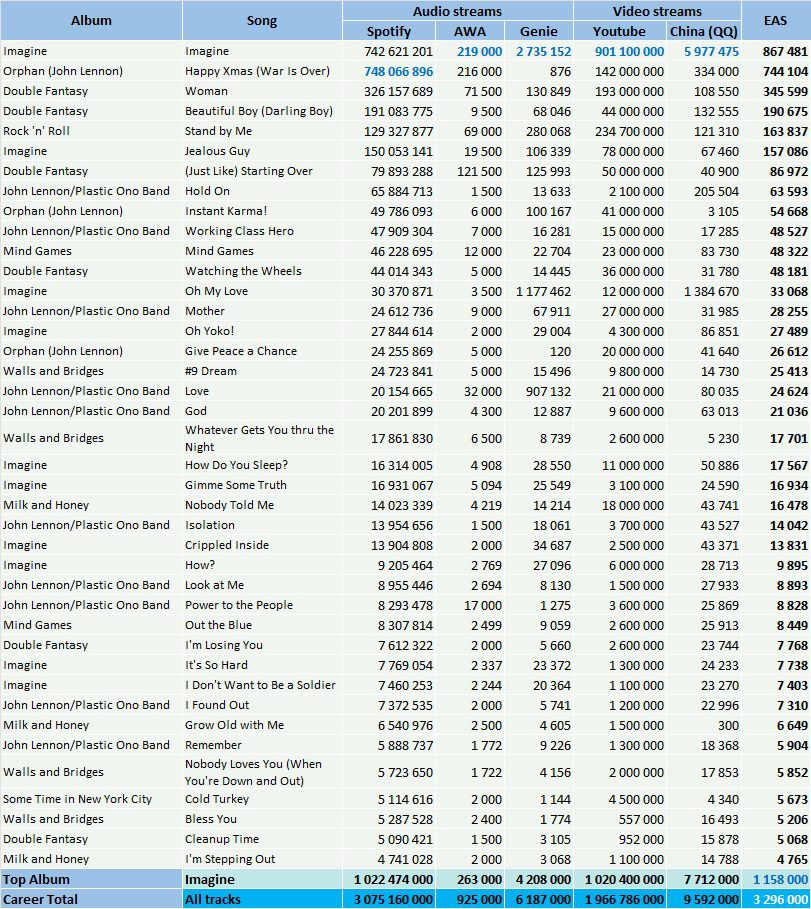
While Imagine has a strong lead over the rest of the pack in most platforms, especially on YouTube with its stunning 900 million views, it is only second on Spotify. The boom enjoyed by Christmas songs due to themed playlists shoot Happy Xmas (War Is Over) to the top of this list. In absolute terms, both songs are huge there with about 750 million streams apiece.
Over 300 million streams on Spotify and closing in 200 million on YouTube, Woman is a distant but solid third. With great numbers too are Beautiful Boy (Darling Boy), Stand by Me and Jealous Guy.
Despite its huge results in its first months for obvious reasons, (Just Like) Starting Over ranks only at 7 here, with streams 10 times lower than Imagine. Hold On follow at 8, while a quartet of songs fight for the top 10 with a virtual tie, Instant Karma!, Working Class Hero, Mind Games, and Watching the Wheels.
It’s worth noting that John Lennon/Plastic Ono Band, Imagine and Double Fantasy have 4 tracks each over 20,000 equivalent album sales from streams. The album Imagine has the highest combined total, clearing 1 billion streams on both Spotify and YouTube.
Full catalog breakdown
If you are familiar with the artist’s catalog and want to check details of each and every song, you can access to all of them right here.
Keep yourself up to date
Our website provides you a fantastic tool which fetches updated Spotify streams as you request them, use it to watch these results grow day after day!
John Lennon compilations sales
It sounds fairly logical to add together weighted sales of one era – studio album, physical singles, downloads, streams – to get the full picture of an album’s popularity.
However, older releases generate sales over various live, music videos and compilation albums. And all those packaging-only records do not create value. They exploit the value originating from the parent studio album with each of its tracks instead. Inevitably, when such compilations are issued, they downgrade catalog sales of the original LP.
Thus, to accurately gauge the worth of these releases, we need to re-assign sales proportionally to its contribution of all the compilations which feature its songs. Here is how we do that.
Assigning compilation sales to original studio albums

How do you understand this table? For example, if we check the The John Lennon Collection line, these figures mean it sold 9,615,000 units worldwide. The second statistics column means all versions of all the songs included in this package add for 1,859,407 equivalent album sales from streams across all formats.
The second part (on the right of the table) shows how many equivalent streams are coming from each original album, plus the share it represents in the overall package.
Therefore, the streaming figures convey that songs from Imagine equate to 55% of The John Lennon Collection‘s tracklist attractiveness. Meaning, it generated 5,278,000 of its 9,615,000 album sales and so on for the other records.
Raw compilations sales
We previously mentioned that some studio album sales from John Lennon may look disappointing. Here’s the reason: he sold plenty of compilations, which ate catalog sales of his initial catalog.
The 1975 Shaved Fish moved 4.7 million units, only to be replaced and topped by 1982’s The John Lennon Collection. Released just after the end of Double Fantasy promotion and of course after his death, it did wonders globally. While it did well in the US (3.3 million) and the UK (1.3 million), it impressed by its sales in various markets like Japan (over 600,000), France (500,000), Canada, Australia and Mexico (around 400,000 each). Worldwide, it moved 9.6 million units.
The lasting appeal of Lennon‘s songs is obvious as these healthy sales were again repeated with 1997’s Lennon Legend. This one sold 7.5 million. Add to that 2.7 million from 1988’s Imagine soundtrack, a combined 3 million for live albums Live Peace in Toronto 1969 and Live In New York City, and a combined 2 million for latter compilations 2005’s Working Class Hero and 2010’s Power to the People.
In the other side, we can see that early albums with Ono were only for purists, with 420,000 sales in total for Two Virgins, Life With The Lions and Wedding Album.
Re-assigned compilation sales – Results & comments
Here is the most underestimated indicator of an album’s success: the amount of compilation sales across all versions that were generated. Due to the dependency of sales of the original studio albums on these releases, they are a key piece of the jigsaw.
To clarify that, we take the Raw compilation sales results and assign the numbers to the related original studio albums, as described in the first section Assigning compilation sales to original studio albums.

This table further confirms that Imagine hasn’t sold more on its original format because its popularity translated into compilations. Tracks from this album, mostly the title track, powered no less than 14.7 million sales.
Double Fantasy is a solid performer too, responsible for over 6 million sales. Interestingly, only Some Time in New York City and Milk and Honey appear to be dead meat. Remaining albums, like Walls and Bridges and Rock ‘n’ Roll, brought good contributions to Lennon‘s catalog too.
Bonus: Top selling compilations’ breakdowns
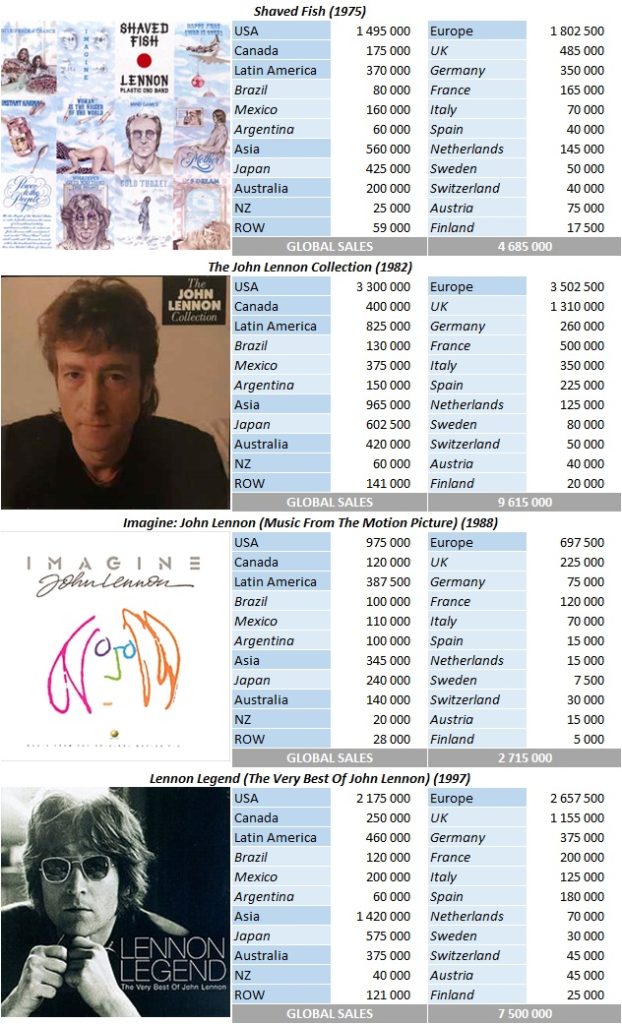
Bonus: Total album (all types) sales per country
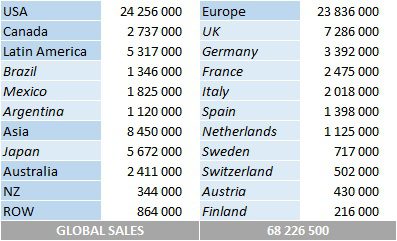
Please note country-specific numbers may miss sales of a few minor releases, although totals are complete.
John Lennon: career results (CSPC)
So, after checking all the figures, how many overall equivalent album sales has each album achieved? Well, at this point we hardly need to add up all of the figures defined in this article!

Albums results (CSPC)
In the following results table, all categories display figures in equivalent album sales. If different, pure sales are listed between parentheses.
As a reminder:
- Studio Album: sales of the original album
- Other Releases: sales of compilations generated thanks to the album
- Physical Singles: sales of physical singles from the album (ratio 3/10)
- Download Singles: sales of digital singles from the album (ratio 1,5/10)
- Streaming: equivalent album sales of all the album tracks (ratio 1/1500 for Audio stream and 1/6750 for Video stream)
Artist career totals
See where the artist ranks among remaining singers
Once we combine its healthy units from every category, Imagine closes counts on near 27 million equivalent album sales. This puts it on par with many strong albums by the Beatles.
At 21 million, Double Fantasy is huge as well. His moderate hit albums, the debut, Mind Games, Walls and Bridges and Rock ‘n’ Roll average 5 million sales each. These are great sales overall.
Even his worst performers, Some Time In New York City and Milk and Honey, are in the multi-million area. Let’s not forget about all the hits which haven’t been part of studio albums, these releases total 10 million units.
With only 8 studio albums, John Lennon sold 83 million equivalent album sales. His 3 million plus sales coming from streams confirm that this tally is poised to go up and up in the future.
Singles results (CSPC)
The list is compiled in album equivalent sales generated by each song. Therefore, these figures are not merged units of singles formats. Instead, the list includes weighted sales of the song’s physical single, download, ringtone and streaming as well as its share among sales of all albums on which it is featured.
Want to compare the act’s songs with other top hits?
Discography results (ASR)
Thanks to our new ASR (Artist Success Rating) concept, we know that sales represent 5.92 million times the purchase of entire discography. Coupled with total sales, it translates into an ASR score of 90. The ranking of all artists studied so far is available too at this link.Records & achievements
- At 26,856,000 EAS, Imagine is the 3rd most successful album from 1971.
- At 20,803,000 EAS, Double Fantasy is the 5th most successful album from 1980.
- John Lennon is one of only 4 artists to release 20 million sellers in 3 distinct decades (60s-70s-80s), the others being Michael Jackson, U2, and AC/DC.
- At 22,190,000 EAS, Imagine is among the Top 10 most successful songs from the 70s.
- At 22,190,000 EAS, Imagine is the 2nd most successful song from 1971.
- Woman replaced Imagine at the top of the UK singles chart in 1981, Lennon was the second artist to do so after the Beatles in 1963.
- Lennon wrote 33 UK #1 hits, tied first with Paul McCartney.
Dynamic Spotify key performance indicators
John Lennon

Current followers count: 6,550,899 6,000,000 followers have been reached on 06/04/24 5,000,000 followers have been reached on 08/05/22 4,000,000 followers have been reached on 03/09/21 >> Daily breakdown
John Lennon is #590 among the most followed artists of all-time >> Visit our Top 5,000 most followed artists ranking
Current streams count: 3,408,444,042 3,000,000,000 streams have been reached on 08/06/25 5,000,000,000 streams have been reached on 08/05/25 2,000,000,000 streams have been reached on 04/07/25 3,000,000,000 streams have been reached on 12/15/24 2,000,000,000 streams have been reached on 11/11/24 3,000,000,000 streams have been reached on 07/20/24 2,000,000,000 streams have been reached on 05/08/23 1,000,000,000 streams have been reached on 05/01/23 2,000,000,000 streams have been reached on 10/31/22 1,000,000,000 streams have been reached on 06/19/20 >> Daily breakdown
John Lennon is #809 among the most streamed artists of all-time Popularity Rating: /100 >> Visit our Top 1,000 most streamed artists ranking >> Visit our Top 20 highest rated artists ranking
Current monthly listeners: 11,027,129 (Trend: 322,411) Global chart position: N/A The artist top 50 cities come from 24 distinct countries >> Global impact breakdown
As usual, feel free to comment and / or ask a question!
Sources: IFPI, Spotify, YouTube, Discogs.
You may be interested in…
… John Lennon‘s streaming masters analysis
… checking out the upcoming artists or even voting for them!
… similar artists
… best-selling artists, albums, and singles
Artists
360° analytics – Best-Selling Artists | by Decade
Tools: Artist Dashboard | Artists Comparator
Streaming deep dive – Most-Streamed Artists
Tools: Playcounts | Royalties | Global Reach | Stats History
Other KPIs – Monthly listeners | Followers | Top money makers
This article is being discussed in our forum, join us to share your comments! »








